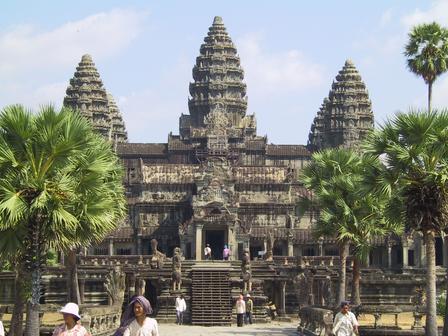Dear friends, this wonderful place, its greatness, its exotic beauty have always fascinated me. This report about the mystery of the many millions of bricks employed in its contruction (which has apparently been solved) has only been a pretext to do this post about it
Mystery of Angkor Wat Temple's Huge Stones Solved
By Tia Ghose, LiveScience Staff Writer | LiveScience.com – 12 hrs ago
 |
| Photo By Paula Bronstein/Staff/Getty Images |
The massive sandstone bricks used to construct the 12th-century temple of Angkor Wat were brought to the site via a network of hundreds of canals, according to new research.The findings shed light on how the site's 5 million to 10 million bricks, some weighing up to 3,300 pounds (1,500 kilograms), made it to the temple from quarries at the base of a nearby mountain.
"We found many quarries of sandstone blocks used for theAngkor temples and also the transportation route of the sandstone blocks," wrote study co-author Estuo Uchida of Japan's Waseda University, in an email.
In the 12th century, King Suryavarman II of the Khmer Empire began work on a 500-acre (200 hectare) temple in the capital city of Angkor, in what is now Cambodia. The complex was built to honor the Hindu god Vishnu, but 14th-century leaders converted the site into a Buddhist temple.
Archaeologist knew that the rock came from quarries at the base of a mountain nearby, but wondered how the sandstone bricks used to build Angkor Wat reached the site. Previously people thought the stones were ferried to Tonle Sap Lake via canal, and then rowed against the current through another river to the temples, Uchida told LiveScience.
To see whether this was the case, Uchida's team surveyed the area and found 50 quarries along an embankment at the base of Mt. Kulen. They also scoured satellite images of the area and found a network of hundreds of canalsand roads linking the quarries to the temple site. The distance between the quarries and the site along the route Uchida's team found was only 22 miles (37 kilometers), compared with the 54 miles (90 km) the river route would have taken.
The grid of canals suggests the ancient builders took a shortcut when constructing the temple, which may explain how the imposing complex was built in just a few decades.
-----------------------------
NOTE: I found this other photo of Angkor Wat which, in my opinion, lets you appreciate its greatness better

Angkor Wat temple, by Andrew Lih (date uncertain)
.